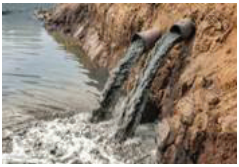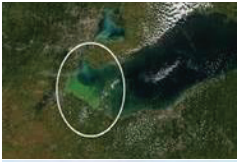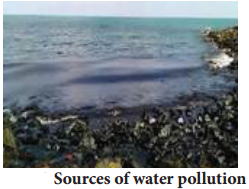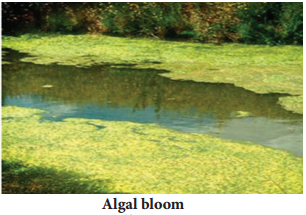Learninsta presents the core concepts of Biology with high-quality research papers and topical review articles.
Water Pollution | Definition, Causes, Effects and Solutions
Quality of Water
Water is essential for life and for the health of the environment. As a valuable natural resource, it comprises marine, estuarine, freshwater (river and lakes) and groundwater environments that stretch across coastal and inland areas.
Water has two dimensions that are closely linked: quantity and quality. Water quality is commonly defined by its physical, chemical, biological and aesthetic (appearance and smell) characteristics. A healthy environment is one in which the water quality supports a rich and varied community of organisms and protects public health.
Water Pollution
Water pollution occurs when there is a change in the chemical, physical or biological quality of water that has harmful effect(s) on living organisms that consume it or live in it. Water pollution adversely affects water bodies due to the large amounts of natural or man-made materials let into it. When it becomes unfit for its intended use, water is considered polluted.
Sources of Water Pollution
Even though water bodies or sources can be polluted by natural causes, water pollution is usually caused by human activities. There are three main types of sources: point sources, non-point sources, leaks and spills.
Point sources:
Discharge of pollutants at specific locations through pipelines or sewers into the water body. Factory effluents, sewage, underground mines, oil wells, oil tankers and agriculture are common point sources (Fig. 12.2 a).

Non-point sources:
Sources that cannot be traced to a single site of discharge like acid rain, dumping of the plastics in water bodies, agriculture chemical run off are common examples (Fig. 12.2 b).

Leaks and Spills:
This occurs mostly due to ship collision, off shore oil rigs, oil leakages and discharges into sea (Fig. 12.2 c).

Sources of water pollution can also be classified in three ways. They are municipal wastes, industrial wastes, and agricultural wastes.

1. Municipal waste water is from homes and commercial establishments.
2. Industrial discharge (effluents) may contain varieties of compounds such as heavy metals (cadmium, chromium, lead), and organic / inorganic chemicals containing waste water, sometimes in toxic concentrations. These discharges can affect temperatures of the water bodies as well as dissolved oxygen level.
3. Agricultural wastes include fertiliser and pesticide runof from agricultural fields, food processing waste, tree and saw dust from logging operations and bacteria from sewage or livestock operations. Water pollutants reach water bodies like rivers, streams and the marine system by precipitation, run-of and the groundwater by seepage or percolation.
Effect of Water pollution on Ecosystems
1. Destruction of ecosystems:
Ecosystems, especially aquatic systems, can be severely affected or destroyed by water pollution. Water pollutants affect existing niches and habitats and the survival of organisms. Soil fertility is affected and the system becomes uninhabitable.
2. Disruption of food-chains:
Water pollution disrupts the natural food chains as well as food webs. Pollutants such as lead and cadmium are taken up by primary consumers where they can be lethal or get stored. Later, when these animals are consumed by secondary consumers, the food chain can get disrupted at any trophic level or result in enhanced concentration of these pollutants (biomagnifiation). Hot water from industries when released into the water bodies affects aquatic density and diversity.
Effect of Water pollution on Organisms
1. Water pollution can be lethal to aquatic organisms and others that depend on these water bodies.
Accidental oil spills from tanker ships can cause substantial environmental damage. Oil spreads on the water surface, prevents the entry of light and oxygen into the water. This increases BOD and COD, resulting in mass death of organisms and degradation of water quality. It also clogs fish gills and the feathers of aquatic birds.
2. Humans and other organisms can get affected by diseases such as hepatitis and typhoid by consuming contaminated water and food. Excess of fluoride in drinking water causes fluorosis. In many poor nations, outbreak of water borne diseases and epidemics are a result of contaminated water and poor or absence of water treatment processes.
3. Water pollution can cause eutrophication due to nutrient enrichment. This causes algal blooms which affect the quality of water bodies (Fig. 12.3). Red tides, if occur, can be lethal to aquatic organisms.

Control Measures
1. Right to clean water is a fundamental right under the Indian Constitution (Article 21).
2. Water (Prevention and Control of Pollution) Act, 1974, sections 17 to 40 prohibit the pollution of a stream or well by disposal of polluting matter.
3. The Central/State Pollution Control Boards have the power to advise the central/state government on various matters concerned with the prevention and control of pollution of water.
4. The Ministry of Environment, Forest and Climate Change (MoEFCC) is the nodal agency of the Central Government for the planning, promotion, co-ordination and for overseeing the implementation of India’s environmental and forestry policies and programmes.
5. National river conservation plan (NRCP) was enacted in 1995 to improve the water quality of the rivers, which are the major fresh water resources in our country. This important assignment taken up under the NRCP includes, To capture the raw sewage flowing into the river through open drains and divert them for treatment.
Setting up sewage treatment plants for treating the diverted sewage. Construction of low cost sanitation toilets to prevent open defecation on river banks.
Prevention
- Regulate or control of pollutant(s) discharge at the point of generation.
- Wastewater can be pretreated by scientific methods before discharge to municipal treatment sources.
- Setting up of Sewage Treatment Plants (STP) and Effluent Treatment Plants (ETP).
- Regulate or restrict the use of synthetic fertilisers and pesticides.
- Public awareness and peoples’ involvement is essential.
Case study
Namami Gange (National Mission for Clean Ganga) Programme is an Integrated Conservation Mission approved as the ‘Flagship Programme’ of the Union Government in June 2014 with a budget outlay of 20,000 crores to accomplish the twin objectives of effective abatement of pollution, conservation and rejuvenation of River Ganga.